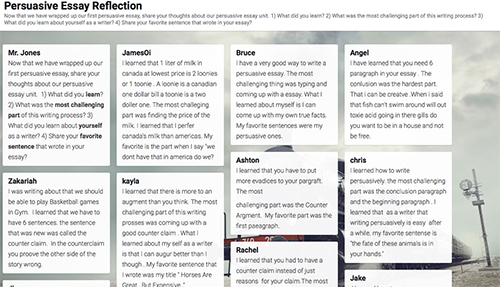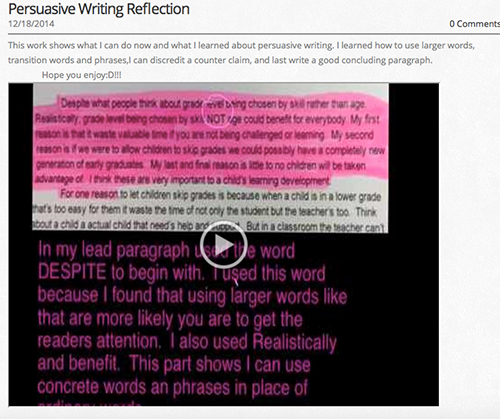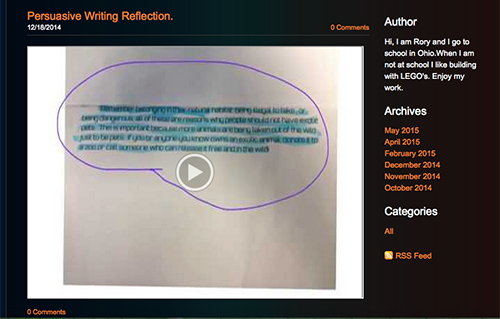Chapter 7: Cultivating Student Ownership with Audience, Autonomy, Discourse and Reflection
7.5 Essential #4: Reflection: The Heart of Learning

As teachers, we know that it is hard to argue with the idea that reflection is a significant part of the learning process. American education theorist and reformer John Dewey states, “We do not learn from experience …we learn from reflecting on experience.” My students and I always conclude our reading and writing workshops with a short debriefing time. I sit in a circle with the other student readers and writers, with notebooks open, and they share their writing process from that day. We ask questions and share our successes and struggles we had. These five to seven minutes are crucial because it grants students the chance to connect their process to their growth as learners. Reflection is fundamental for my young readers and writers to realize their work is about the process of learning, not always the final scores or end results.
Persuasive writing seems to be a very challenging genre of writing for my fifth graders. That is not to say that fifth graders can’t argue. On the contrary, this age group can be very proficient at arguing when given the opportunity. However, developing a 5-6 paragraph opinion piece that uses multiple reasons and supporting details for each argument, along with counter arguments, to support a point of view has proven to be grueling for many of my students. This compelled me to incorporate more reflection into our persuasive writing units. Here are two examples of how my students used digital tools to make their reflection public.
Digital Bulletin Boards
With regards to student reflection, digital bulletin boards (e.g. Padlet, Corkulous and Popplet) are wonderful tools to make students’ reflection public. Why make reflection public? I believe that students sharing their learning process with their peers only heightens awareness of their strengths and next-steps. That embodies what it means for students to take ownership and control of their learning.
After our first persuasive writing unit, I felt it was important to see where my students were in their understanding of this type of writing. I asked students to post their thoughts onto our class digital bulletin board. (e.g. What did you learn? What was the most challenging part of this writing process? What did you learn about yourself as a writer? Share your favorite sentence that wrote in your essay.) I was able to use this information as a formative assessment of their learning, and students were able to read their peers’ strengths and struggles. Let’s take a look at a few examples of how my students used the digital bulletin boards for reflection.
* Link to our Persuasive Essay Reflection digital bulletin board
Madison
I learned that you have to have details for your reasons. The most challenging part was trying to find strong reasons for my point of view. I learned about how I can put transitional words in my writing as a writer. My favorite sentence was when I told the people that watch too much television “Stop watching television and exercise!”
When I read Madison’s reflection, I noticed that she learned a great deal about herself as a writer. She learned the importance of using details to support her arguments, and she claimed that this was the most challenging aspect for her. Also, Madison integrated transitional words throughout her writing (e.g. for example, firstly , in conclusion). As a result of this reflection, I gleaned that I could scaffold Madison as she worked to include supporting details throughout her information and persuasive writing. Another teaching point for Madison could be to encourage her to keep using transition words as a way to show express agreement, compare/contrast arguments, emphasize a point or add information.
ReAnne’
My favorite sentence that I wrote was at the end is mom you should get me a new laptop! Also I learned was how to start your intro paragraph.It was hard to think what I want to start it with.The most challenging part was my last paragraph to wrap up my essay.It was hard because it took me a little while to think what I want to say so I did some thinking and said “Mom now you should get me a new laptop because one getting homework done before someone else gets on,two if I’m not on a family member needs to get on they can,three I can play video games before or after dinner or even homework.Those are my reasons so I can get a better laptop before christmas.Mom now go get me a new laptop!”
ReAnne’s reflection indicated that she struggled with finding an effective way to start and end her essay. The fact that this was a challenge indicates that she understands the importance of these two paragraphs as bookends for the essay. As I continued to work with ReAnne through writing conferences, I planned to check in and offer feedback about her writing choices for introducing and concluding her writing pieces. It seemed that ReAnne would benefit from some mentor texts with strong introductions and conclusions and I provided those for her too.
Screencasting Whiteboard Apps
Screencasting Whiteboards (e.g. Educreations, Explain Everything) are another excellent way for students to display their learning and reflection. Students worked far more independently on their second persuasive writing experience. Without as much scaffolding as before, it was time for students to share their purposeful writing decisions that went into their writing. Students used the interactive whiteboard app Explain Everything to share three parts of their persuasive essay. I wanted them to think like writers, and explain their purpose and intentions with the decisions they made as writers. Here are some examples of the students’ screencasts as they reflect on their writing process.
 Upon viewing Tiara’s screencast it’s clear that Tiara has gained much insight into herself as a writer. She starts her essay very intentionally. She writes, “Despite what people think…” because she says that using larger words has a better chance of grabbing the reader’s attention. Secondly, it’s clear that Tiara is writing with her audience in mind. The fact that she is using transition words to organize her writing indicates that she sees the purpose behind organizing her writing. Lastly, Tiara shows the importance of revising during the writing process by giving some examples of “ordinary words that (she) exchanged for larger words.” Tiara’s screencast indicates that she is a strong writer that has learned a great deal about audience and purpose. All in all, it seems that Tiara is a very strong persuasive writer.
Upon viewing Tiara’s screencast it’s clear that Tiara has gained much insight into herself as a writer. She starts her essay very intentionally. She writes, “Despite what people think…” because she says that using larger words has a better chance of grabbing the reader’s attention. Secondly, it’s clear that Tiara is writing with her audience in mind. The fact that she is using transition words to organize her writing indicates that she sees the purpose behind organizing her writing. Lastly, Tiara shows the importance of revising during the writing process by giving some examples of “ordinary words that (she) exchanged for larger words.” Tiara’s screencast indicates that she is a strong writer that has learned a great deal about audience and purpose. All in all, it seems that Tiara is a very strong persuasive writer.
Rory’s screencast also indicates how he has become much more intentional as a writer. His first piece of evidence indicates the importance of the introduction paragraph as a way to state his point of view. Also, Rory included a counter-argument in his persuasive essay. He states how he uses this opportunity to discredit an opposing argument. Finally, he points out that he tries to give his readers a “guilt trip” as a method of convincing his readers to agree with his point of view. Similar to Tiara, Rory has made some very intentional writing decisions.

Digital Portfolios — Reflection During The Learning Journey
Student reflection about their thinking is such a crucial part of the learning process. That is why I must continue to find ways to help students increase the quality of their reflections included in their digital portfolios. One way to do this is to be a role model of reflection. I need to continue to think aloud during mini lessons and make my thinking and reasoning clear and obvious. A second way to strengthen my students’ reflection skills is to keep on incorporating it into our regular conversations. I’ll invite students to have conversations about their problem-solving processes. A third method to make sure reflection is always at the forefront is to continue to design questions that will encourage students to share their new understandings. I’ve seen the power of well-crafted question or sentence prompt, and how it can push students to think beyond the final product and focus on the learning process. Here are some examples of ways I question or prompt students:
“Prompts to Encourage Reflection” Presentation
Classroom Implications of Reflection
By making reflection a key component into our daily literacy work, my students have realized that learning is not always about facts and details. Rather, learning is about discovery. Students need to discover their own reading and writing process, strategies to build comprehension and make their own meaning about texts. My role is to guide and facilitate their reflection so they can monitor and refine their own learning process. As a result of making their reflection public using digital bulletin boards, students are more attentive to their progress and next steps they need to take to reach their learning goals. In conjunction with public reflection, students used a screencasting app to explain the thinking behind their writing choices.